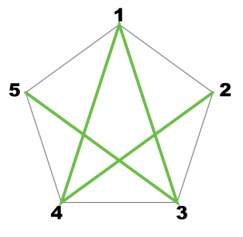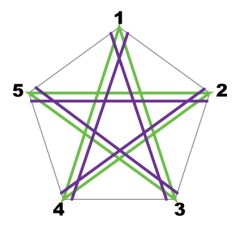 For an introduction to what goes on in this column, click here.
For an introduction to what goes on in this column, click here.
I thought at first that I’d use duplicate stitch for the stars on Rosamund’s costume, but duplicate stitch has one great weakness. You are limited to embroidered stitches the size and shape of your knit stitches.
That means her stars would have looked something like this.

Not even in my most wishful state of mind is that a five-pointed star. That looks like a Space Invader doing front squats. Unacceptable.
In the dim recesses of my memory lurked an image of my late grandmother, the tailor, embroidering perfect five- and six-pointed stars on a client’s fancy party outfit. I dug through every embroidery guide on my shelf–about two dozen books, from the eighteenth century to the present–and found nothing. The entries for “Stars, embroidered” led to this kind of thing…

which is fine for folksy work, but not what I needed; or this kind of thing

which is a Lazy Daisy, not a star. Don’t try to tell me otherwise.
I began to wonder if past-life regression therapy might get me where I needed to go. Or perhaps I ought to hire a medium? Would my grandmother be annoyed if I contacted her in the great beyond to ask how she put the stars on Mary Ellen Zemicki’s bicentennial hostess pajamas? Was there a good time to call? When do they air Lawrence Welk in heaven?

Star Map
Meanwhile, I went ahead and mapped out the placement of the stars on the tail of the costume. I used contrasting yarn and basting to give myself a set of guidelines, just as I’d done for the eagle.

Oh Say Can You Sew
In the end, a séance was just too much work to throw together quickly and I had to rely on experimentation and blind luck. I could remember this: you began by embroidering something that looked just like a child’s drawing of a five-pointed star. And I half-remembered a chant that started, “One and three, and two and four…”.
I cracked it. Here it is.
This is not a complicated stitch. I’m going to break it down very, very carefully so you can do it on your own without getting lost.
Our star will be based on an underlying shape: a pentagon. The five points of the pentagon will become the five points of our star, and we number them like so for reference:

We begin with a base layer, worked once, like this:
Needle up at 1, needle down at 3.

Needle up at 2, needle down at 4.

Needle up at 3, needle down at 5.

Needle up at 4, needle down at 1.

Needle up at 5, needle down at 2.

The base layer is now complete.
From here, we continue ’round and ’round the points of the star in rounds that grow smaller and smaller until the center of the star is filled in. All of these rounds follow the same rules, and here they are.
Needle up just below and to the left of point 1.
Needle down just below and to the right of point 3.

Needle up just below and to the left of point 2.
Needle down just below and to the right of point 4.

Needle up just below and to the left of point 3.
Needle down just below and to the right of point 5.

Needle up just below and to the left of point 4.
Needle down just below and to the right of point 1.

Needle up just below and to the left of point 5.
Needle down just below and to the right of point 2.

Round complete.
Continue in this manner, with the stitches of each round being taken a little closer to the center of the star. This diagram shows (in blue) what the next round will look like after it has been worked. The star is complete when the center is filled in, ending with a stitch from 5 to 2.

The key is:
“Up at the left.
Skip a point.
Down at the right.
Back a point.”
If you remember that, you’ll remember the stitch.
Tips…
When you’re learning this stitch, rotate the work as you go so that the point you are dealing with is pointing UP. This will help you keep your “rights” and “lefts” clear.
Each round of stitching moves a little closer to the center of the star. How much closer? About the thickness of your embroidery yarn is a good bet.
Tip your needle so that you taking all stitches after the base layer from just under the threads laid down in the previous layer.
The number of round you’ll require to fill in the center of the star will depend upon the dimensions of the star and the size of your embroidery yarn.
Perfect and Uniform
One perfect star is a fine thing to achieve, but a field of many looks best if all are uniform in size and spacing. I’d laid out my guidelines, but I knew I couldn’t freehand twelve matching stars. Variation is fine for a folksy look, but not for this project.
So I printed out a plain pentagon of the proper size, and traced the points twelve times onto a sheet of medium weight water-soluble stabilizer with a fine-tipped permanent marker.


I cut out the pentagons as I needed them, one at a time, and pinned them to the sweater.

Using a sharp chenille needle with an eye large enough to accommodate my yarn (a size 18, in this case), I embroidered the stars over the stabilizer and the knitted fabric. A blunt tapestry needle won’t work well with stabilizer.

When they were all complete, I immersed the sweater in plain, cold water to remove the stabilizer. Voilà.

Do allow the piece to dry completely, of course, before trying it on.
Tricolor Muffin Hat Pattern Now Arriving on Runway Four
Meanwhile, we’ve put together the pattern for the Tricolor Muffin Hat. It’s free–just click HERE.

It may be, of course, that red, white, and blue is not your cuppa tea this winter; so here are some possible alternate color sets in HiKoo Simplicity (with coordinating LOVaFUR pompoms) for your consideration.
With Pompom: Fox–Scarlet 399032-0015


With Pompom: Raccoon–White 399028-0001


With Pompom: Luxury Raccoon–Black


With Pompom: Luxury Raccoon–Royal


With Pompom: Kids Gold–Leopard


What’s up next?
Well, if you stop by in two weeks I’ll show you what I’m doing with these…

…and a couple bottles of paint.
Tools and Materials Appearing in This Issue
HiKoo Simpliworsted (55% Merino Wool, 25% Acrylic, 17% Nylon. 140 yards per 100 gram hank)
HiKoo Simplicity (55% Merino Wool, 28% Acrylic, 17% Nylon. 117 yards per 50 gram hank)
Delilah Undyed DK Yarn (100% Baby Llama, De-Haired. 109 yards per 50 gram hank)
LOVaFUR Handmade Vegan Fur Pompoms
addi® Click Turbo Interchangeable Needle
About Franklin
Designer, teacher, author and illustrator Franklin Habit is the author of It Itches: A Stash of Knitting Cartoons (Interweave Press, 2008). His newest book, I Dream of Yarn: A Knit and Crochet Coloring Book was brought out by Soho Publishing in May 2016 and is in its second printing.
He travels constantly to teach knitters at shops and guilds across the country and internationally; and has been a popular member of the faculties of such festivals as Vogue Knitting Live!, STITCHES Events, the Maryland Sheep and Wool Festival, Squam Arts Workshops, the Taos Wool Festival, Sock Summit, and the Madrona Fiber Arts Winter Retreat.
Franklin’s varied experience in the fiber world includes contributions of writing and design to Vogue Knitting, Yarn Market News, Interweave Knits, Interweave Crochet, PieceWork, Twist Collective; and a regular columns and cartoons for Mason-Dixon Knitting, PLY Magazine, Lion Brand Yarns, and Skacel Collection/Makers’ Mercantile. Many of his independently published designs are available via Ravelry.com.
He is the longtime proprietor of The Panopticon, one of the most popular knitting blogs on the Internet (presently on hiatus).
Franklin lives in Chicago, Illinois, cohabiting shamelessly with 15,000 books, a Schacht spinning wheel, four looms, and a colony of yarn that multiplies whenever his back is turned.
Follow Franklin online via Twitter (@franklinhabit), Instagram (@franklin.habit), his Web site (franklinhabit.com) or his Facebook page.
